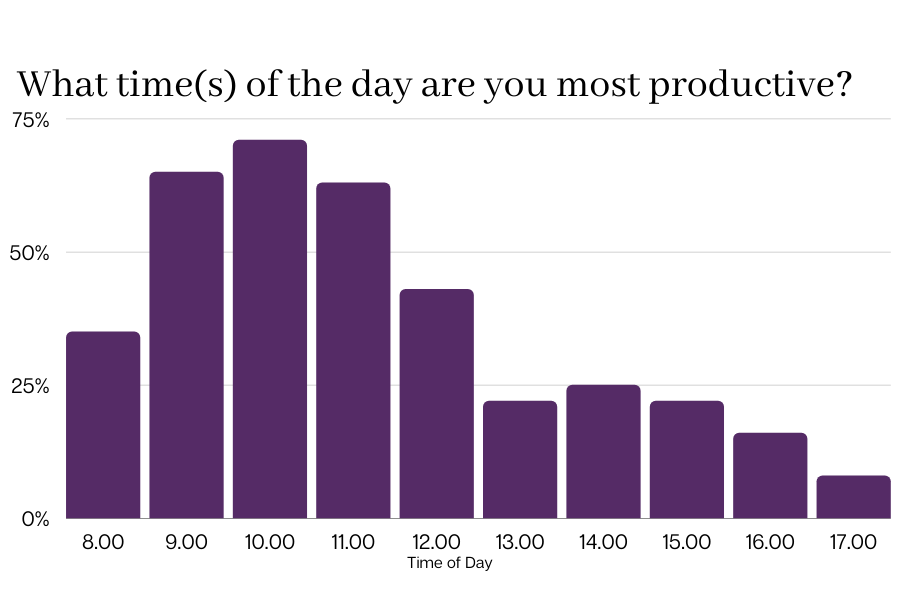The Secret to Improving Team Productivity

Do you want to know the secret to improving your team’s productivity and helping them have a better workday? Cancel all 10.00 am meetings and think twice before you interrupt them. It may sound too good to be true, but these two small actions will result in significant change as they enable your team to do the one thing they really want – complete their work.
I conducted the first “A Better Workday” survey in 2020 to gain a deeper understanding of how we can improve the workday for our teams, and ourselves. Seventy people in different roles and global locations participated, and the results were fascinating in their simplicity.
People want to be able to get their work done and believe that being more considerate and helpful is the key to a better workday for everyone.
What time of the day are you most productive?
Do you know what time of the day is best for you to tackle the most important tasks? Is it the same for your team? Within the typical business hours of 9-5, the majority of survey respondents said they were most productive between 09.00 am and 12.00 noon, with 10.00 am being the most popular hour for getting things done.

It is impossible to say whether this is because most desk-based professionals are early birds or because they have adapted to fit their working schedule. A small percentage of participants indicated that their most productive times were outside of business hours, in the early morning or late in the evening. However, they have autonomy over their schedule and flexibility with their working hours; something that many team members don’t have.
If you knew that most of your team members were most productive before lunch, how would that change the workday? Would you take steps to create a supportive environment to get their work done during that time?
What does “a better workday” mean for you?
“A better workday” means different things to different people, from a safer working environment to more flexibility in the working day. Some people would like a better balance between work and their wellbeing, whereas others state that having clear goals and priorities is key to them having a better workday.
But over 60% of people described “a better workday” as a day where they can finish their tasks and make progress.

People seek a working environment where they can complete the work assigned to them. The question is, why can’t they get their work done?
What is the biggest drain on your productivity?
According to this survey, too many meetings and interruptions are the most common things which get in the way of a productive workday. Each of these factors is listed by over a third of respondents. Procrastination takes third place, and this has become a bigger problem for teams who are working remotely in response to the pandemic; without the hum of the office and the connection to work colleagues, some people are finding it more difficult than others to motivate themselves.

Is the solution to cancel all meetings and ban interruptions in the workplace? Not only does this seem counterintuitive to our nature, but it will also cut out those meetings and interruptions which are valuable and help drive the business forward. Teams need to continue to work together, but perhaps it is time to look at how we can help each other more.
How can others help you have a better workday?
When is the last time you considered how others could help you have a better workday? Taking the time to think about the role the rest of your team plays in the achievement of your goals is worthwhile. Otherwise, we may always feel like we are swimming against the current.
Consideration of workload and schedule, fewer and better meetings, and a reduction in interruptions are three ways which you could help the people you work with to have a better workday.

Understanding the workload of others is especially important in teams that are working remotely or who work on their own projects/tasks, rather than shared teams projects. In these cases, it is sometimes difficult to see just how much is on your colleague’s plate. This is where communication plays an important role; whether it is using a tool to give more transparency across the team or by having a quick conversation with someone before assuming they can take on more work. The role of the manager is critical here as they should have a birds-eye view of the team, and be able to identify which members can take on more work at different times.
If meetings and interruptions are listed as the top two things preventing people from getting there job done, it is no surprise then that you can help others have a better workday by having less of both.
Meetings have been a pain-point long before the shift to remote work and will continue to be so, regardless of where team members are working from, if a company doesn’t actively address it. Reducing the number of meetings alone is not enough; the quality of the meetings also need to be improved. If each person takes responsibility for improving the quality of the meetings they schedule, a positive domino effect will ripple throughout the team and into the broader organisation.
Five questions you should ask yourself for every meeting:
-
What is the purpose of the meeting?
-
What type of meeting is it? (For example, a status update meeting is very different from a brainstorming meeting and so would have other requirements).
-
What would a successful meeting look like?
-
Who is required to make this meeting a success?
-
How can I make this meeting successful?
Interruptions are not a new problem either; however, each new digital communication tool introduced to the workplace gives team members a new and convenient way to do so. No longer do you need to be in the same physical space at the same time to interrupt your team member. You can do it from anywhere. What impact does this have on the person you are interrupting? Research has shown that they will work on two other things before returning to the task at hand about 25 minutes later and, in 23% of cases, they won’t return to it at all during the same working day. If you have ever wondered why projects end up taking longer than expected, this is a clue to one of the contributing factors. So what can you do to interrupt people less?
Wait before interrupting someone.
It really is that simple. If you do this, one of a few things may happen.
Three reasons you should wait before interrupting someone:
-
You might discover that you don’t need to interrupt that person after all.
-
You may identify more things that you need to discuss with them, and can address them all together.
-
You could make more progress in your own tasks by not interrupting your own work to interrupt someone else.
Are you worried that you will forget to speak with that person if you don’t do it right this second? Put a placeholder into your calendar to follow-up with people and keep a running list throughout the day.
How can you help others have a better workday?
50% of people in the survey want to help others have a better workday by offering their support and help.

Transfer of knowledge is critical to successful teams, and people want to do it. The only problem is that they don’t even have the time to finish their own work, never mind help someone else. Here we see the full vicious circle. A workday without space makes it extremely difficult to both complete tasks and to help others when needed.
Creating more uninterrupted space within the day allows people to finish their work, feel a sense of progress and achievement, and be available to help their colleagues.
Being more available will enable people to build personal relationships which they consider to be an essential aspect of a better workday for both themselves and others.
You can create this space by adopting a favourable schedule within a team; not everyone’s day will look the same, but there will be typical times where the team will expect no meetings and no interruptions. This schedule would be clearly visible, most likely as blocks in a calendar, so other people in the company are also aware of these times.
Some companies have introduced no meeting days, which is a positive step in this direction, but this is not as effective if people are being interrupted continuously. Creating space for focused work is not merely a change in the calendar; it is a change in how people approach their work and that of their colleagues. To be successful, this type of change needs to happen at all levels, and leaders must lead by example.
Depending on the team and the type of work, this scheduled space could be as little as one hour each day so you may ask yourself, is it worth the effort? But that time will allow people to be more productive than they had been able to be previously, while also allowing them to have a better workday. So the only question left to ask is – why not do it?


